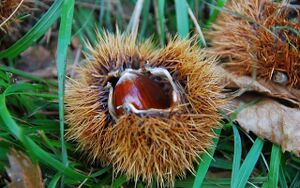Castagna di Montella (Montella chestnut)

IGP Castagna di Montella is a medium-small to medium sized chestnut of a mainly roundish form with a flat lower face, convex base, blunt top, short tuft, elliptical hilar cicatrix, thin brown pericarp, easily detached from the episperm which in turn is easily separated from the seed, the meat of which is white, crisp and sweet,
GEOGRAPHICAL AREA: area in the Communes of Montella, Bagnoli Irpino, Cassano Irpino, Ñusco, Montemarano and Volturara Irpina, located in the Province of Avellino.
EVIDENCE: Montella chestnuts began to acquire international renown in the 19th century along with the first period of emigration to America and Canada. Consumption of the product later was extended from the immigrants to the local population. Currently over 50% of the product is exported to America, where it is marketed with the label "Castagna di Montella" ("Montella chestnuts"). Another 25% of production is exported to Europe, and the remaining 25% is divided between the industrial partially-processed and the home markets.
METHOD OF PRODUCTION: The Montella chestnut is at least 90% derived from the "Pallumina" variety, and the remaining maximum 10% from other varieties, in particular the "Verdola". The chestnut woods for the production of Montella chestnuts must have the traditional environmental and cultivation conditions of the area and must give the product the specific quality characteristics. All forcing practices are prohibited. The maximum allowable yield in Montella chestnut production is 25 kg. per plant and 3 tonnes per hectare. Montella chestnuts may also be marketed dried, in the shell, whole shelled or as chestnut flour. The dried product must meet the following requirements: - dried on metal or grating with a slow, continuous fire fed exclusively by faggots or firewood of any type, according to the traditional local methods already being used by producers; - moisture content of whole nuts or flour not to exceed 13%; - immunity to parasites of any type whatsoever (insect larvae, molds, etc.); - the yield in dried chestnuts with the shell from 100 kg must not exceed 60%; dried shelled chestnuts must be whole and sound, of a straw-white colour and with not more than 10% of blemishes (wormeaten traces, deformations, etc.).
LINK: The chestnut is a typical crop of the hilly and mountainous area of Avellino. It became important economically following the development of steamship navigation and the subsequent migration of the local population to the United States and Canada. 50% of the product is currently being exported to these two countries, and the remaining portion goes to the home and European markets and to partial processing for use in industry (chestnuts for confectionery making).
Reference: The European Commission
#chestnuts #chestnut #dried #nutsgrainsandseeds #nuts #flour